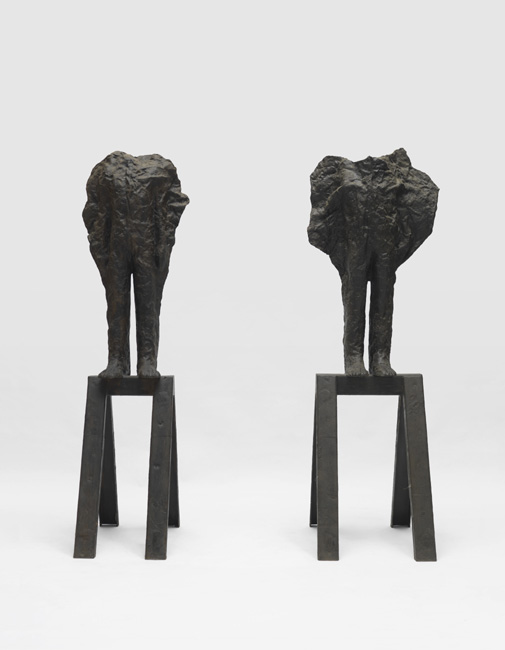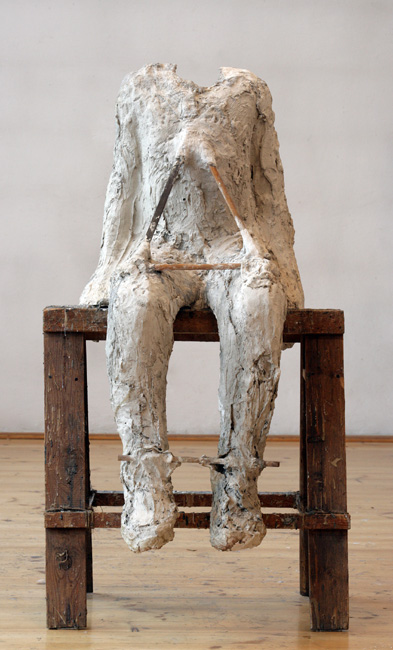Marlborough Barcelona is pleased to announce a solo exhibition of Polish artist Magdalena Abakanowicz
From November 17th to January 7th, Marlborough Barcelona will present a group of works by Magdalena Abakanowicz (Falenty, 1930), who is recognized as one of the most innovative sculptors of the last fifty years. The exhibition will consist of fourteen works that were created from 1987 up to the present day.
The artist’s work is fully connected with her personal experience and the political and cultural events unleashed in Poland during the second half of the 20th century, where she has lived and worked all her life. The German occupation during World War II and the subsequent Communist regime imposed by the Soviet Union made a deep and lasting impression on the artist, who at an early age witnessed the innate human tendency for destruction and cruelty.
In the mid-sixties, Abakanowicz became known worldwide due to the use of fiber in her creations, especially with her Abakans, large fabric structures in red, ocher or black which hung from the ceiling. Later, she gained praise for the astonishing sculptural ensembles, Crowds, Walking Figures and Standing Figures. These frequently appear as groups of headless bodies placed next to each other forming a kind of army. Through explorations in a variety of materials (wood, stone, paper, clay and especially bronze) Abakanowicz has shown her commitment to the many facets of the human experience and to the body itself. In addition to the Crowds, the artist also creates sculptures of individual body parts, many of which can be found in the exhibition: representations of the face, the hand, torso–all embodiments of the intrinsic life force in human beings.
Among the exhibited pieces is Plaster Body 5 (1987), an imposing headless figure that retains its own kind of dignity. Within the cycle Anatomy are the pieces Anatomy Cycle: Anatomy 31 and Anatomy 21 (both from 2009), a hand and an arm detached from the body. Other important works come from her series Anonymous Portraits (1987) and Anonim (2009), in which the artist presents heads without bodies, their faces blurred and anonymous. As Gloria Moure states in her catalogue essay, “It is the body understood as a unit of awareness and memory, as a common place of sensations, emotions and feelings. Then, the work is a transit, a journey, a flow”. In Figure in Iron House (1989-90) viewers witness a lonely figure in an iron cage. Also included in the exhibition are the sculptures Winged Sister and Winged Brother (2005-06), two figures without heads in bronze that are regal monuments to the human condition. Finally, the gallery will present a selection of the artist’s drawings with examples such as Drawing from Cycle Flowers – Falenty Flower or Flower of Minimus Pali (1998-1999), in which body and nature appear to converge within the same form.

Abakanowicz, Winged Brother and Sister, 2005-06, bronze
Magdalena Abakanowicz has been the subject of over 150 solo exhibitions in Europe, North and South America, Japan, South Korea, and Australia. She has exhibited at The Metropolitan Museum of Art in New York, the Jardins du Palais Royal in Paris, and the Muzeum Narodowe in Poznań. Her recent solo exhibitions include the Palacio de Cristal, Museo Nacional Centro de Arte Reina Sofía, Madrid and the Institut Valencià d’Art Modern (IVAM), Valencia, both in 2008, and the Fondazione Arnaldo Pomodoro, Milan, in 2009.
Several examples of her work were on display in the Energy and Process galleries at the Tate Modern, London for all of 2010, as well as in her survey exhibition, The Human Adventure exhibited at the Akbank Art Center, Istanbul, in 2013. Among numerous awards and distinctions, Abakanowicz has received seven honorary doctorates from universities in Europe and the United States as well as the Commandeur de l’Ordre des Arts et des Lettres from the French Ministry of Culture. She was also awarded the prestigious International Sculpture Center’s Lifetime Achievement Award in 2005.
Over the past three decades Abakanowicz has developed a number of site-specific sculpture installations that incorporate multiple figures or elements of increased scale. Among these are Negev at the Israel Museum, Jerusalem, 1987; Space of Dragon, Olympic Park, Seoul, South Korea, 1985; Space of Becalmed Beings, Hiroshima City Museum of Contemporary Art, Japan, 1993; Sarcophagi in Glass Houses, Storm King Art Center, New Windsor, New York, 1994; Space of Unknown Growth, Europos Parkas, Lithuania, 1997-98; Unrecognized, Citadel Park, Poznań, Poland, 2002; Space of Stone, Grounds for Sculpture, Hamilton, New Jersey, 2002 and, most recently, Agora, a sculptural group comprised of 106 unique cast-iron figures measuring over nine-feet tall that was permanently installed in Chicago’s Grant Park in 2006.
Abakanowicz’s work can be found in numerous public collections including: the Israel Museum, Jerusalem; Ludwig Museum, Cologne; Musée National d’Art Moderne de la Ville de Paris and the Centre Georges Pompidou, Paris; The Tate Modern, London; The Museum of Contemporary Art, Chicago; The Museum of Modern Art (MoMA) and The Metropolitan Museum of Art in New York; Storm King Art Center, New Windsor, New York; Frederic Meijer Gardens, Grand Rapids, Michigan; San Francisco Museum of Modern Art (SFMOMA), San Francisco; Nelson-Atkins Museum of Art, Kansas City, Missouri; Nasher Sculpture Center, Dallas; National Gallery of Art and the Hirshhorn Museum in Washington D.C., and the Sezon Museum, Tokyo, to name a few.
Courtesy of Galería Marlborough
























